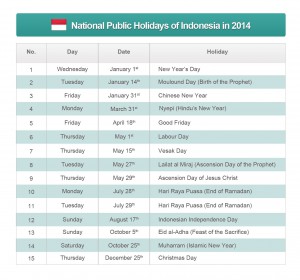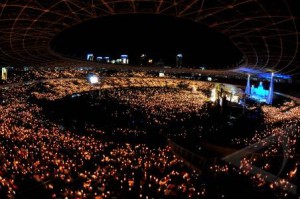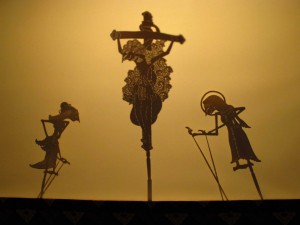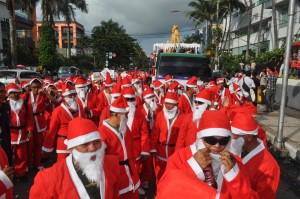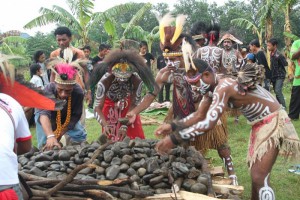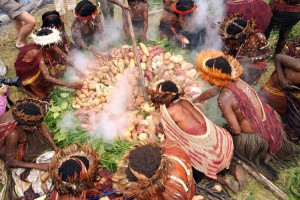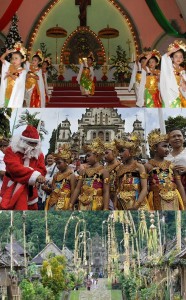Christmas Celebration in Indonesia Posted by asimonoff on Dec 31, 2014 in Uncategorized
Christmas is one of most celebrated religious holidays in Indonesia, after Eid al-Fitr, the Islamic religious celebration. In big cities and areas with majority Christian communities, the spirit of Christmas celebrations can be seen and felt everywhere; houses and malls are adorned with Christmas decorations. Christmas songs, especially “Malam Kudus” or “Silent Night,” are sung and played in the malls, on radios, and on television. There are also Christmas songs live on stage in several malls. Just like Christmas celebration tradition all over the world, “Sinterklas” or “Santa Claus,” dressed in red and white becomes an essential part of the celebration in Indonesia.
The month of December is not only associated with a religious event, but also family togetherness as it coincides with school holidays. It is also the time of the year when businesses offer a lot of clearance and discounted items. Families enjoy their outings and the festivity and, of course, shopping.
When Christmas time is fast approaching, Indonesians start to feel the pinch of their daily expenses as food prices skyrocket, especially the price of red chili peppers. Interestingly, the scarcity of red chili peppers, at times, becomes a national food crisis that requires government intervention. The reason is that a lot of Indonesian cuisine uses chili peppers as the main ingredient — the spicier, the better.
Christmas time is also considered a very important time for Indonesia, to send a message to the nation that the country still upholds the principle of inter-religious harmony or religious tolerance as the Indonesian way of life. It is a time to express that Indonesia, as a pluralistic country, is united. The president and vice president and their wives, who are Muslim, usually attend a Christmas celebration in one of the Christian communities in the country. This year, in 2014, the Majelis Ulama Indonesia, the Indonesian Ulema Council (MUI), through its chairman, also openly wish Christians in Indonesia a Merry Christmas to promote unity and religious freedom, even though this goes against the beliefs of Muslim conservatives, who claim that giving a Christmas greeting is haram (religiously forbidden).
Those who do not know Indonesia might be surprised that Christmas is celebrated in the country. It is quite understandable as Indonesia often misconceived as an Islamic state instead of the country with the largest Muslim population in the world. Even though Muslims officially account for around 88 percent of the population of 252 million, religious freedom is guaranteed by constitution, the UUD 1945. Among the religious minority in Indonesia, Christians are the largest group, making up approximately 8.8 percent of the population. Protestantism and Catholicism are among the six officially recognized religions, along with Islam, Hinduism, Buddhism, and Confucianism. All of these religions’ major religious holidays are national holidays.
In Indonesia Christmas is celebrated in a unique cultural way:
- In Jakarta, Christians hold a mass prayer service in Gelora Bung Karno stadium.
- In Yogyakarta, the priest or pastor usually leads mass wearing a traditional beskap suit and blangkon hat while speaking in soft Javanese, complete with a Wayang Kulit (shadow puppet) performance called “The Birth of Christ.” People also have a tradition of visiting relatives’ homes, similar to Eid al-Fitr, and children sometimes receive money from their elders.
- In North Sumatra, the Batak community has a tradition they call Marbinda, which is sacrificing an animal together on Christmas day. The community collects money for the purchase, and the meat is distributed among those who chip in.
- In Manado, North Sulawesi, Christmas celebrations begin on December 1 with pre-Christmas practices done until Christmas day. Many also have the tradition of visiting the graves of their loved ones, usually after Christmas but before New Year’s Eve, and having a picnic at the graveyard. Christmas celebrations continue until the first Sunday in January, ending with the kunci taon tradition in which the community parades the streets and villages.
- In Ambon, sirens of ships and church bells can be heard through the city on Christmas Eve. Families get together, and youngsters stay up the whole night to light fireworks.
- In Papua, the community holds a “bakar batu” or “barapen” or “stone burning” party. It is a local culinary ritual for cooking pig meat as a part of celebrating the birth of Jesus Christ. Women bring produce from their own farms as part of the cookout.
- Christians in Bali celebrate Christmas by wearing traditional clothing from their respective regions, such as kebaya, sashes, and kamen fabric in black and white. On Christmas day, church complexes are decorated with bamboo and janur, which is a distinctive ornament in Bali known as Penjor.
Selamat Hari Natal dan Tahun Baru 2015 — Merry Christmas and Happy New Year 2015.
Indonesian terms and words
- UUD 1945 usually referred to by UUD’45 it is a short of Undang-Undang Dasar 1945, is the Indonesian constitution.
- Kerukunan antar umat beragama – inter-religious harmony.
- Hari libur nasional – public holidays
- Perayaan natal – Christmas celebration
- Umat Kristen, Umat Nasrani – Christians
- Agama Islam – Islam
- Agama Kristen – Christianity
- Agama Hindu – Hindu religion
- Cabe/cabai merah – red chili pepper

Build vocabulary, practice pronunciation, and more with Transparent Language Online. Available anytime, anywhere, on any device.
About the Author: asimonoff
I’m an Indonesian language instructor, instructional material developer, reading test developer, and interpreter. I have been teaching Indonesian to adult students for 15 years, and have been teaching students from many backgrounds, such as private, military and diplomatic service employees. I’m Indonesian, but am living in the US now; my exposure to different cultures in my home country and in the US has enriched my knowledge in teaching Indonesian as a second language. I approach the teaching of the Indonesian language by developing students’ critical cultural awareness and competence. This method of teaching has been proven to be a key to the success of my students. Students become conscious of the essential role culture plays in the language.



